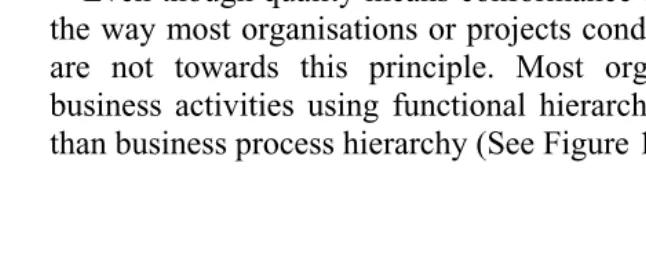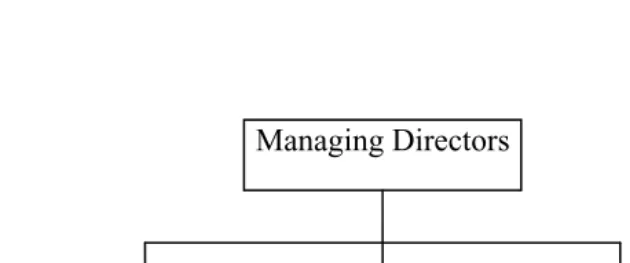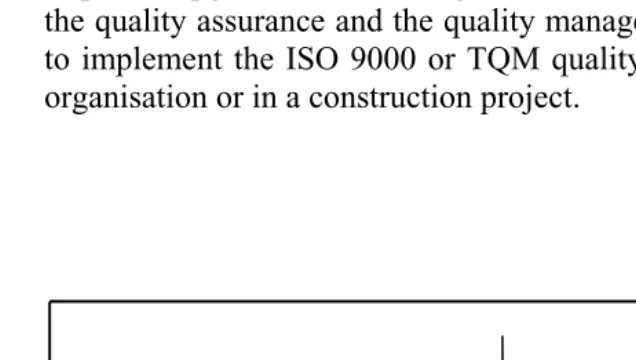1
AN OVERVIEW OF QUALITY MANAGEMENT
SYSTEM IN CONSTRUCTION
Abdul Hakim Mohammed Mat Naim Abdullah
INTRODUCTION
The study on the QMS in construction industry would be difficult to proceed if the definition of the quality and the QMS are not well understood. Therefore, this chapter begins with the discussion on both subjects.
DEFINITION OF QUALITY
The term ‘quality’ is one that is often used in daily conversation but frequently without much thought as to its meaning. There are various definitions of quality. Deming (1986) the famous quality guru defined quality as a predictable degree of uniformity and dependability, at low cost and suited to the market. Crosby (1986) definition on quality is conformance to requirements while Juran (1995) said quality is fitness for purpose.
customer-supplier relationship in actual business situation is complex especially in construction world where many parties working together to produce a single end product.
Most of the above definitions of quality are based on production and manufacturing precepts. The definition of quality in the construction is the degree of compliance with contract specification (Gibson and Hamilton 1994, Ledbetter 1994). This definition is supported by Leon (1995) who characterised the construction quality as follows:
“In the construction realm, quality is directly linked to the formal contract requirements, specifications, agreements, client preferences, and instruction that undoubtedly influence every technical and commercial decision made from the boardroom to the project site. Some contracts may need to be clarified due to ambiguity, grey areas and shortcomings. The attempt is therefore to identify, mutually agree and satisfy project requirements. This scenario facilitates quality to be defined as’ Meeting Agreed Requirements’. It should be noted that such a definition provides for the meeting of external and internal requirements; as in the external and internal customer”.
THE EVOLUTION OF QUALITY PROGRAMMES
The definition of quality given by Feigenbaum (1991) stressed that quality programme is required throughout the process of realising the product or service. In the past, the quality level of an item was defined more by the experience of a manufacturer. A quality programme then was simply an activity of inspection where a final product was tested against a specified manufacturer’s standard. The activity will distinguish between a good or bad product, by comparison with the standard (Fox, 1995). The result of this inspection activity is whether the tested product is rejected or accepted.
An Overview of Quality Management System in
Construction 3
the limit where it has to be rejected. Thus, it will benefit the production company in term of amount of saving due to reduction in rejected items.
However, inspection and quality control are unable to ensure whether the product satisfy the users or not. A product may achieve higher standard as compared to the specified standard but it still may not satisfy the customer. This led to the development of a quality assurance system. A quality assurance system is an external quality system covers activities aimed at inspiring confidence in the client that the supplier’s quality system can provide a product or service that will satisfy the client’s quality requirement (Abdulaziz and Tawfiq, 1999). The instigation of ISO 9000 in 1980’s is a result of the quality assurance programme. ISO 9000 is a model of quality standard that sets minimum requirements for main activities to achieve quality of a product in the eyes of the customer.
In real meaning the QMS is only an extension of quality assurance system with additional quality elements tailored to organisation’s own requirements. That explains why sometimes quality assurance system is also referred as QMS. Total quality management (TQM) and the latest version of ISO 9000 that is ISO 9000:2000 are example of models of QMS.
An Overview of Quality Management System in
Construction 5
engineering has been used as a covering label for process management, process innovation and process redesign. Hammer and Champy (1993) had defined BPR as “the fundamental rethinking and radical redesign of business processes to achieve dramatic improvement in critical contemporary measures of performance, such as cost, quality, service and speed”. Love and Li (1998) concluded that whatever definition used to describe BPR, it shares a common theme, that is, the company embarks on a radical change initiative, essentially focusing on employee empowerment and rethinking and redesigning the ways in which its business process (management and operational) are performed. The expected result in adopting BPR is quantum improvements in performance in service and manufacturing. The key words to understand BPR are “radical change to business process so as they are focussed to satisfy customer”.
Even though quality means conformance to customer requirements, the way most organisations or projects conduct their business process are not towards this principle. Most organisations perform their business activities using functional hierarchy (See Figure 1.1) rather than business process hierarchy (See Figure 1.2).
Figure 1.1: Functional hierarchy
Managing Director
Contract & Procurement
Department
Administration Department
Figure 1.2: Process approach
The consequences of working under a functional department is the sub-ordinates striving to gain their superior’s satisfaction rather than focusing on business process that brings satisfaction to the user of their department’s product or service, eventually to the user or customer of the organisation’s product or service. For instance, in construction, the process of developing a project involves various parties. The process normally starts with the client highlights his requirements and then follows with the consultants produce the drawings, estimation and tender document and when the contract was awarded, the contractor undertakes the construction works. In process management, the immediate receiver of a product or service is considered a customer. In this instance, the customers of the client are the consultants and because of that he has to define his requirements clearly otherwise, the drawings, estimation and tender document produced by them will not to his expectations. The process flows on with the customer of the consultants is the contractor. Again, the quality of the contractor’s work and any variation depends on the quality of the drawings; tender document etc. (product). In reality, because of the functional hierarchy, the construction parties tends to work in isolation and therefore creates variations, crises,
Managing Directors
Contract & Procurement
Department
Administration Department
Construction
An Overview of Quality Management System in
Construction 7
misunderstandings and eventually affect the end product causing client and user dissatisfaction.
The above scenario explains why the QMS is a pre-requisite for adopting the CI and BPR. Thus, without a standard process to achieve customer satisfaction and the organisation’s goals, any improvement whether incremental or radical is of no use and impractical to be applied.
In short, the evolution of the quality management can be referred to Figure 1.3. Based on the definition of inspection and quality control, it is not obvious to state that the quality level of Malaysian construction industry is currently at those stages (Leon, 1995). Thus, the rational step is to upgrade to a second generation of quality programme that is the quality assurance and the quality management. In detail, it means to implement the ISO 9000 or TQM quality system in a construction organisation or in a construction project.
Figure 1.3: Quality Spectrum (Adapted and edited from Kost, 2000
Quality Control
Quality Assurance
Quality
UNDERSTANDING QMS
The definition of QMS given by Abdulaziz and Tawfiq (1999) had been described above. Another approach to define the QMS is in accordance to ISO 8402. ISO 8402, the vocabulary of quality defined quality management as “all activities of the overall management function that determine the quality policy, objectives and responsibilities, and implement them by means such as quality planning, quality control, quality assurance and quality improvement, within the quality system”. Meanwhile, the definition of quality system according to ISO 8402 is “the organizational structure, responsibilities, procedures and resources needed to implement quality management”.
Combining the definitions of ‘quality system’ and ‘quality management’ thus concludes that QMS is the interaction of people, processes and documentation to meet both customers’ stated and implied needs (See Figure 1.4).
Figure 1.4: The structure of QMS
The result would be a reduction in inefficiencies and waste, improved work practices, increased morale and the opportunity for a greater market share. All these benefits are achieved through the
Process People
An Overview of Quality Management System in
Construction 9
implementation of QMS which ones should perceive it as a wide-scale failure prevention programme that will lead to costs savings (See Figure 1.5).
Figure 1.5: Cost Savings of QMS (Adopted from Lam et al, 1994)
QMS IN CONSTRUCTION AND RELATED PROBLEMS
The industry had lived in the quality programme of inspection and quality control for years. Construction materials and construction works were accepted or rejected base on the inspection and quality control. However, the introduction of BS 5750: Quality Systems in the UK in 1980’s had changed the perception of the construction industry’s peoples in managing quality in construction environment. The introduction of ISO 9000 in the same period had accelerated the process of introducing the quality management concept to the construction world. ISO 9000, being an international standard for quality system, has been very popular to be used as quality assurance system. Many international construction clients especially the Europeans require their construction team to be registered with the scheme that it is appeared as the ISO 9000 registration is a mandatory if an organisation wish to venture in Europe.
Failure Costs
Apprais al Costs Cost
Savin
Prevention Costs
After QMS Before QMS
Prevention Costs
However as construction is a project-based industry, the success of QMS implementation should not be measured at the company level rather the benefits should be extended to the project level. The following sections will discuss in detail on the implementation of QMS at company and project level.
COMPANY-BASED QMS
A review on the literature regarding the QMS in construction over the last ten years showed many studies had been focussed on the company-based QMS. The majority of the studies were on the ISO 9000 QMS. A few were on the TQM, as evidenced from the statement made by Oakland (1995) that “for the last five years TQM featured in only three out of 70 articles on quality in construction”.
The focal points of the study on the implementation of ISO 9000 QMS in construction organisations were on the applicability, benefit and obstacles of implementing it. Another popular approach was many researchers reported the findings of their study in their country such as Bray (1995) for the USA, Low and Henson (1997) for Singapore, Kam et al (1997) for Hong Kong, Giles (1997) for the UK, Hung (1999) for Taiwan, Abdulaziz and Tawfiq (1999) for Saudi Arabia and Wan Yusof et al (1994) for Malaysia.
During the 1990’s many researchers reported the benefits and advantages enjoyed by an ISO 9000 certified construction companies and some also highlighted the problems encountered by the companies especially at the initial stage of ISO 9000 implementation (Low and Goh, 1994; Eltigani and Djebarni, 1996; Low and Henson, 1997; Hareton et al, 1999; Abdulaziz and Tawfiq, 1999 and Tat et al, 1999).
In general, the benefits and advantages reported by the above authors can be summarised as follows:
a) communications would be improved; b) reduce rework;
An Overview of Quality Management System in
Construction 11
e) increase market share.
Various obstacles in the implementation of the ISO 9000 construction industry had also been identified by the some researchers (Low and Goh, 1994; Wan Yusoff et al, 1994; Oakland and Aldridge,1995; McCabe, 1996 Low and Hennie, 1997; Giles, 1997; Abdulaziz and Tawfiq, 1999) and the followings are the summary:
(a) Resistance to change;
(b) Misconception of the ISO 9000 quality system;
(c) Quality perceived as something secondary to the business;
(d) Scheme may have appeared too complex;
(e) Lack of understanding of the ISO 9000 quality standards;
(f) High cost especially the initial cost;
(g) Loss of productivity of the workforce due to the effort exerted in learning and implementing the new system besides their regular duties;
(h) Absence of special regulation that make it incumbent upon contracting companies to establish and implement QMS;
(i) No encouragement from the construction industry clients; and
(j) Difficult to apply to the construction industry.
Some of the authors also gave suggestions to remove the obstacles such as:
(a) providing an industry-wide awareness course and training for quality;
(c) providing incentives such as job guarantee and national quality award.
The researches on the company-based QMS in construction can be considered as comprehensive in view of the various aspects of implementation have been studied, for instances:
(a) measuring the effectiveness of the QMS in construction organisations by Al Nakeeb et al (1998) and Low et al (1999);
(b) QMS and productivity in construction organisations by Eltigani and Djebarni (1996);
(c) training programme under QMS for construction organisations by Lo (1998),
(d) quality costs for construction organisations by Low and Henson (1998) and Davis (1987);
(e) legal implication of QMS on construction organisations by Netto et al (1997); and
(f) QMS and quality culture in construction organisations by Low and Winifredo (2001).
An Overview of Quality Management System in
Construction 13
PROJECT-BASED QMS
In reality there is no such term as ‘Project-based QMS’. ISO 9000, TQM or any quality programmes are organisation-based. The reason is all quality programmes are originated from manufacturing sector where normally the products are processed by a single entity. This situation is not typical in construction industry. Construction is a project-based industry where different parties work together to achieve the quality of the construction works. Barrett and Grower (1998) had figured out that for those companies that have achieved certification, the actual impact on the quality of the service from the client’s viewpoint has been only slightly positive and does not correlate in any way to the importance of the factors such as accessibility of personnel, appearance of staff, client’s technical input, frequency of communications, interest and enthusiasm of professional, politeness of support personnel, professionalism demonstrated, speed of response of client’s needs, standard of presentation, technical correctness of service, understanding of client’s organisation and understanding of client’s problems.
This effort will ensure a goal congruent among the parties involved in the construction work.
The traditional way of managing the relationship between the parties involved in the construction works is through the contract agreement. The existing contract agreement is normally based on the traditional roles and authorities that have been accepted and recognised by the industry. The emerging of the QMS concept if successfully adopted by the contractors (being an internal system) could indicate the removal of external quality controls (inspection and testing by the architect, engineer or clerk of works) traditionally practiced in building contracts (Netto et al, 1997). Some researchers suggested that amendment should be done on the existing forms of contract (Low and Goh, 1994 and Leon, 1994) and others such as Nesan (1995) suggested a contract structure that fit the partnering arrangement should be developed to cater the TQM environment.
CONCLUSION


